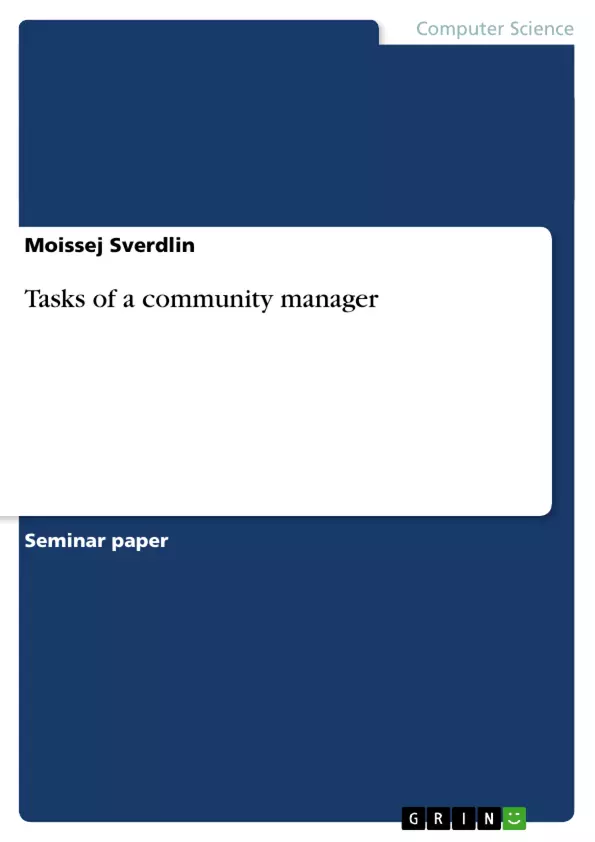The Internet has evolved in the last 15 years in such a speed and in such a mass that the world has changed dramatically. If in the year 1985 a normal West German student would have wanted to learn about new developments in the world he had watched news in the television or had read a newspaper. But if he wanted more specific information about something then there were no means left. Today at every minute of the day in every city of the world {with Iridium Satelite Phone coverage, it is possible to get an Internet connection at every point of the world} [www.iridium.com , accessed on the 18thof May 2005] every human being can receive every information she or he desires. We are in the information society!
That information we require can come from different sources. It can be trusted news service like CNN [www.cnn.com], a well known encyclopedia e.g. the Encyclopedia Encarta [www.encarta.com] or a rather informal source e.g. a virtual community like Well [www.well.com]... Wait a moment! You might ask yourself why after the most famous news network and the largest encyclopedia in the world I have mentioned a virtual community… The answer is clear the internet has evolved so much that today it is possible to get almost every answer you want from almost every specialist you want for free! [Concept from: Rheingold 1993, chapter 1]
What does it mean? It means that millions and millions of internet users are exchanging their thoughts and combining their knowledge for an exchange of information2. Declaration of my research question
As the subject of my paper is the “tasks of a community manager” I have thought which aspects of the work of a community manager would be an interesting subject for this study. Traditionally a management position is a position which requires academic knowledge; trust from the subordinates and a responsibility for the company and its employees. In the case of a virtual community manager, those three aspects are still the same. Since trust in virtual communities is part of another paper and erudite knowledge in the area of community managing is a very well spread area, the aim of the following 6 pages will be to answer my question:
“What are the responsibilities a Community Manager has to take care of?”. Classification of virtual communities
Inhaltsverzeichnis (Table of Contents)
- Introductionary words about Virtual Communities
- Declaration of the research question
- Classification of Virtual Communities
- Definition of a Virtual Community
- Work areas in virtual communities
- Human Resources infrastructure of a virtual community
- Needs of Virtual Communities
- Financial Needs
- Technological Needs
- Social Needs
- Areas of Community Managing
- Knowledge Management
- Community Building
- Supervision of Employees
- Financial Oversight
- Communication in Virtual Communities
Zielsetzung und Themenschwerpunkte (Objectives and Key Themes)
This paper explores the tasks and responsibilities of a community manager in the context of virtual communities. The author delves into the various aspects of managing a virtual community, emphasizing the importance of understanding its unique needs and characteristics.
- The definition and classification of virtual communities
- The specific needs of virtual communities, including financial, technological, and social aspects
- The key areas of responsibility for community managers, such as knowledge management, community building, and financial oversight
- The importance of communication and its role in fostering and managing virtual communities
- The structure and dynamics of human resources within virtual communities
Zusammenfassung der Kapitel (Chapter Summaries)
- Chapter 1: Introductionary words about Virtual Communities: This chapter explores the rapid evolution of the internet and its impact on the creation and growth of virtual communities. It highlights the accessibility and potential for knowledge sharing that these communities offer.
- Chapter 2: Declaration of my research question: This chapter outlines the research question that the paper aims to address: "What are the responsibilities a Community Manager has to take care of?". It emphasizes the importance of understanding the unique challenges and opportunities presented by virtual communities.
- Chapter 3: Classification of virtual communities: This chapter delves into the definition and classification of virtual communities, drawing on the work of Howard Rheingold and Derek M. Powazek. It explores the different types of communities, including those focused on support, shared stories, and commerce. The chapter also examines the different work areas within virtual communities, such as moderating, technical supervision, designing, and financing.
- Chapter 4: Needs of virtual communities: This chapter focuses on the various needs of virtual communities, highlighting the importance of financial resources, technological infrastructure, and social elements. It explores different funding models, including advertisements, merchandising, and donations.
- Chapter 5: Areas of Community Managing: This chapter explores the key areas of responsibility for a community manager. It covers aspects such as knowledge management, community building, supervision of employees, and financial oversight. The chapter emphasizes the role of the community manager in ensuring the successful functioning and growth of the virtual community.
Schlüsselwörter (Keywords)
The paper centers around the concepts of virtual communities, community management, online communities, knowledge management, communication, and human resources. It explores the specific challenges and opportunities presented by managing online communities, drawing on examples from different types of virtual communities. The author emphasizes the unique nature of virtual communities and the key responsibilities of community managers in ensuring their successful functioning and growth.
- Arbeit zitieren
- Moissej Sverdlin (Autor:in), 2005, Tasks of a community manager, München, GRIN Verlag, https://www.grin.com/document/63737



